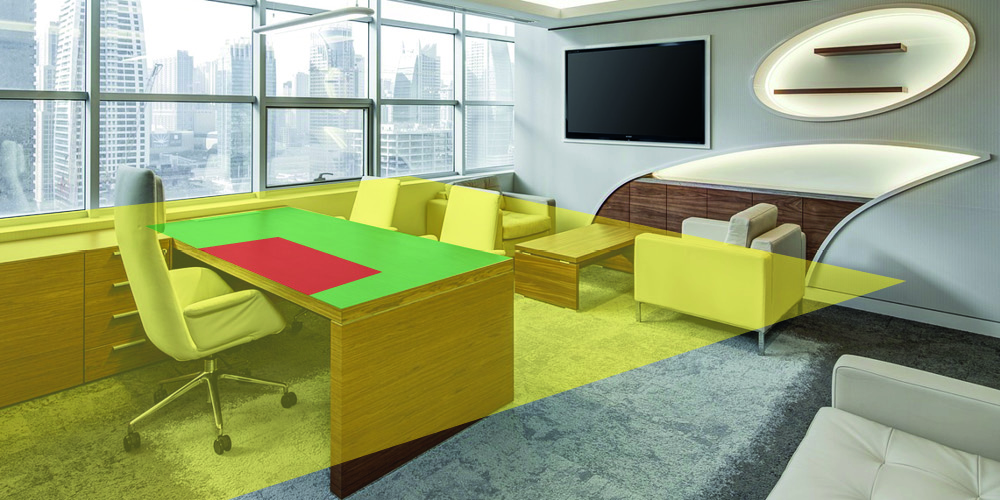Workspace lighting

Table of contents
The quality of lighting in the workplace plays a fundamental role in the well-being of workers. It must be thought out and adapted to each space in order to favour optimum working conditions.
The impact of light on our lives
Thousands of years of human evolution without the presence of artificial light have left us with a natural reaction to sunlight. Without artificial light, the close relationship between the presence of light and human daily life was more evident. To summarise:
At sunrise, a dim, warm light, around 2700K, aims to awaken our bodies to the day that is just beginning;
Throughout the morning, sunlight becomes more intense, reaching its peak around midday - when you would expect our energy to be at its highest. At midday, sunlight has a colour temperature of around 5500K;
As the afternoon progresses, the colour temperature becomes warmer again, with blue tones giving way to yellows. Naturally, our energy decreases, providing a more relaxed state suitable for rest time.

Today we live in environments that are also artificially lit. This lighting can replicate, regardless of the time of day, any type of light that we would previously only get naturally. For this reason, it is extremely important, and becoming increasingly evident, to adapt lighting not only to the function of the spaces, but also to the time of day, whenever possible. To address this problem, Human Centric Lighting emerged.
The importance of lighting in the workplace
The effect of light on the human body can be seen in our energy levels, mood and ability to concentrate. Good lighting is essential, and there are already several scientific studies that point to the correlation between correct lighting in the workplace and the quality, productivity, motivation and well-being of the worker.
Poor lighting not only impairs visual comfort, but also increases other symptoms that cause discomfort such as eyestrain, blurred vision, visual irritability, headaches and muscle pain, stress and difficulty concentrating.
Decreased visual acuity, a consequence of fatigue, does not only depend on lighting conditions, although this is one of the major influences. Other factors that affect visual acuity are:
- The person's own eye characteristics - older age and/or eye diseases such as myopia and astigmatism.
- The presence of disturbing factors, such as unprotected light sources (luminaires without diffusers, for example) that cause glare.
- Incorrect positioning of the computer screen in relation to natural or artificial light sources, such as placing a monitor facing a window.

For those who work with computer screens, visual fatigue can also stem from the position of the eyes in relation to the computer monitor. A distance of 30cm between the eyes and the screen is recommended, as well as keeping the visual horizon above the top of the screen - in this way, a larger area of the cornea will be protected by the eyelid.
Light sources
Generally speaking, we can divide light into two large groups according to its source: natural and artificial.
Natural light
Natural light from the sun can and should be used to illuminate interior spaces. Through windows and glazed surfaces installed in walls or ceilings, it is possible to benefit from sunlight, although you should always consider how to regulate the entry of light to avoid glare.
Artificial light
Supplied by lamps and luminaires, it can have different intensities and colour temperatures, depending on the type of use and preference.
Workspace lighting
Workplace lighting should be thought of in three layers:
Work surface — must be suitable for the job performed;
Task area — illuminating the area around the work surface makes it possible both to demarcate zones where certain types of work take place and to contribute to good surface illumination;
Room related — this type of lighting must be uniform and is especially important in places that will be flexible in terms of the tasks to be carried out.

Red is the work surface, in green the task area and in yellow the room related.
Each layer can benefit from one or more types of lighting, in terms of the direction of the light beam - direct, indirect or combined. Direct lighting is when the beam of light falls directly on the area to be illuminated and indirect lighting is when the beam of light is directed towards another surface which, in turn, will illuminate the desired area by reflecting the light. The two types of lighting can also be combined, using luminaires with direct or indirect beams or, opting for a more recent solution, luminaires that emit more than one beam of light.
Ambient lighting can be provided by ceiling luminaires that illuminate directly or in combination. Task area lighting, on the other hand, can benefit from all types of lighting. The work surface, depending on the task to be performed, can be illuminated directly or combined - by one or more luminaires.

Luminaires with direct, indirect and combined beam direction.
Workspace lighting must prioritise performance, which depends on luminous intensity and cascading, visual comfort, through the choice of an appropriate CRI and brightness, and ambience, with the selection of an appropriate colour temperature and light direction.
How much light is ideal for each space?
The choice of lighting characteristics is intended to provide a comfortable, performance-optimising and safe workspace. There are standards that serve as a basis for determining the amount of light that should fall on each surface, depending on its purpose. This concept is called illuminance, is expressed in lux and can be measured using specific equipment - the luxmeter.
The level of illuminance is crucial for performing tasks without errors and avoiding fatigue. Places where detailed tasks are carried out and which require good visualisation naturally need greater luminosity than other places with less detailed tasks.
In addition to illuminance, another very important factor for good lighting is the UGR - Unified Glare Rating. This index measures the psychological glare effect of a lighting installation in interior spaces. The UGR depends not only on the luminance of the luminaires, but also on the position and direction of the observer's gaze and the luminance of the environment, to which, in addition to the luminaires, other light sources such as screens and windows contribute.
Here's a short list of the illuminance and UGRL levels (UGR limit value) recommended for some indoor locations, according to EN 12464-1 - Lighting of work places:
Circulation zones — 100 lux, UGRL 25
Staircases — 150 lux, UGRL 25
Waiting rooms — 200 lux, UGRL 22
Receptions — 300 lux, UGRL 22
Classrooms — 300 lux, UGRL 19
Shops — iluminação geral — 300 lux, UGRL 22
Offices, meeting and conference rooms — 500 lux, UGRL 19
Craft classrooms — 500 lux, UGRL 19
Shops — checkout area — 500 lux, UGRL 19
Examination and treatment rooms — 500 lux, UGRL 19
Examination and treatment rooms — meticulous work surface — 1000 lux, UGRL 19
Operating theatres — 1000 lux, UGRL 19
Precision work zones — 1000 lux, UGRL 16

Workplace lighting should enhance worker performance, but never neglect worker comfort. Although these are general recommendations, the lighting of each space must be thought out individually, through the realisation of a luminotechnical study, which allows each space to be illuminated according to its own functionality and characteristics.
Other articles

29/01/2024
Food product lighting

26/03/2024
Human Centric Lighting

23/04/2024
Luminotechnical study

20/01/2024
The Impact of Lighting on Sales

19/04/2024
Lighting products for retail

16/05/2024
What is UGR and GR?

15/03/2024
Advantages of using LED technology

14/10/2024
The impact of lighting on productivity

12/01/2024
Kitchen lighting


Add new comment